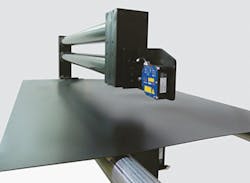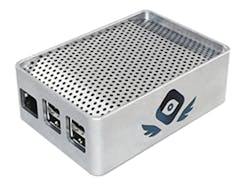Developments in extrusion include a monitor for film and sheet that can also provide full machine control, and a simple, wireless approach to continuous data analysis.
FILM & SHEET GAUGE SCALABLEFROM MONITORING TO CONTROL
The ability to control parameters such as pressure, temperature and speed now can come at the end of a film or sheet extrusion line, said Tim Fisher, the owner of Factory Automation, Controls & Technical Services Inc. (FACTS). The Cuyahoga Falls, Ohio, product supplier has systems that make that possible.
FACTS' laser triangulation measurement (LTM) C-frame gauge and shadow micrometer eddy (SME) gauge both measure the total thickness of a sheet or film, and not individual layers within a product, Fisher said. When integrated with FACTS control systems, LTMs can actually be used to make production adjustments, based on sheet thickness. They not only represent a departure from traditional designs that include radioactive materials, but also can become the primary control in a film or sheet extrusion line.
"I think of sheet and film gauging systems that measure thickness, including scanning measurement systems or fixed-place measurement systems that check product thickness, fall into the category of monitoring," Fisher said. "In this sense, some processors want monitoring typically to check a final product parameter such as the thickness of a sheet or film or the diameter of tubing." The company offers a portfolio of control systems, information management systems and measurement products.
FACTS last year introduced the LTM gauge, designed to handle film and sheet with thickness of 10 mils and up, in widths of up to 5 feet, at scanning speeds of up to 6 inches per second. The complete system includes a sensor assembly, console, scanning frame and controller.
The LTM gauge incorporates two laser sensors mounted opposite each other on the end of the C-frame arm, with one above the web and one below. "It is called laser triangulation measurement because it uses two displacement lasers — they are called displacement because they are measuring a distance to a target," said Fisher. One laser measures the distance to the top of the film or sheet surface, the other measures the distance to the bottom of the surface. LTM determines the thickness of the product based on those measurements, along with the value of the distance between the two lasers, Fisher said.
The LTM gauge is suitable for measuring opaque products and materials that are rigid, flexible, conductive or nonconductive.
Other features include a belt-driven linear actuator, closed-loop servo control, and proximity sensors that warn if the gauge — which moves along the base of the C-Frame — reaches its travel limits. The sensor is also used for positioning the gauge.
Late last year, FACTS also rolled out an upgraded version of SME, which is designed to measure continuously extruded products with thicknesses from 0.002 to 0.5 inch up to 12 feet wide at rates of up to 10 inches per second. SME is suited for any product that is nonconductive and flexible enough to make a 45-degree wrap around a reference roller. It can be used with foam sheet, multilayer sheet, film and materials that are heavily pigmented or highly filled, Fisher said.
SME consists of a noncontact LED micrometer and precision eddy current sensor mounted in a single housing. The SME housing is positioned over the reference roll in a manner that enables the LED micrometer to measure the distance the product extends above the surface of the roll. SME uses the eddy current sensor to locate the surface of the roll in order to calculate product thickness.
"The laser system looks across the reference roll and is measuring the change in diameter of that roll that is due to the thickness of the product. If you looked at the end of the roll, then wrapped it with a 0.5-inch film, it would see a diameter larger than the roller diameter. That thickness change is what the shadow micrometer is measuring. But because the roll is not perfectly round, SME uses an eddy current sensor that measures the distance to the roll itself. It cannot see anything nonconductive and measures the distance to the true surface of the metal roll, while the shadow micrometer measures the distance to the top surface. The difference is the true thickness," Fisher said.
SME also has a belt-driven linear actuator, proximity sensors for travel limits and positioning and closed-loop control.
Unlike other sensors, the gauges contain no radioactive materials. Fisher says the industry is moving away from nuclear gauges, which require certified technicians to test them to ensure that no radiation is leaking.
WIRELESS PRODUCTION MONITORINGFROM NEW SOURCE
Oden Technologies Inc., a 2-year-old New York company, developed Hugin, a new process monitoring technology for industrial applications that connects wirelessly to a machine and transmits operational data from machine sensors to a cloud-based analytics program that generates performance and predictive values.
The Hugin hardware, about the size of a bar of soap, plugs into the digital communication port on existing machines and sensors in an extrusion plant. A built-in SIM-card and proprietary software within the Hugin device connect through a virtual private network (VPN), eliminating the need for a WiFi signal on the plant floor, said company co-founder Peter Brand. Both the analytics platform and database are located on a cloud-based server. Hugin can connect to an individual machine or to locally networked machines.
Users can access and organize the data on a customizable dashboard that is displayed on a monitor. "The Hugin device is self-provisioning. Just connect it to the machine and it will start collecting data in real time and send it to our cloud platform," Brand said.
Oden has targeted extrusion as the initial market in the plastics industry. "We have installed the Oden platform [and Hugin] on plastic extrusion lines serving the wire and cable industry. We focused on that industry because after having surveyed cable factories, we knew that we could provide value due to the continuous, high-value nature of most cable and the many process variables involved in production. The plastic compound extrusion process in wire and cable has a carryover into profile, pipe and tubing extrusion, which can benefit from better process transparency for the same reasons," Brand said.
Mikell Knights, senior correspondent
Contact:
FACTS Inc., 330-928-2332, www.facts-inc..com
Oden Technologies Inc., 847-204-6113, http://odentechnologies.net


